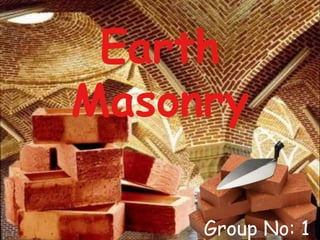
Earth Mesonry
- 2. WHAT IS EARTH MASONRY? Earth A stable, dense, non-volatile inorganic substance found in the ground (The New Oxford Dictionary of English, 1998) Masonry The art of shaping, arranging and uniting stone, brick, building blocks, etc., to form walls and other parts of a building (Dictionary of Architecture & Construction, 1975).
- 3. MATERIALS OF EARTH MASONRY • Bricks • Rubble • Sand • Concrete rubble • Cement • Lime • Mortar • Grout materials • Water • Additives
- 4. HISTORY OF EARTH MASONRY Jethawanaramaya Sri Lanka -Established in the 3rd century Pyramids in Egypt The Great Wall of China
- 5. BRICKS The main constituents of brick-making clays are silica (sand) and alumina, but with varying quantities of chalk, lime, iron oxide and other minor constituents. SIZE 215mm Stretcher face 65mm 102.5mm Header Face
- 6. CLASSIFICATION OF BRICKS TYPES OF BRICKS Clay bricks Calcium silicate bricks Concrete bricks http://buildingmaterial1213.blogspot.com
- 7. Extraction of the raw material Forming processes Bricks Marking process
- 8. Drying Forming process of clay bricks can be done by four methods: Handmade - Pallet moulding - Slop moulding Soft mud process Pressed bricks Extruded-wire cut bricks
- 10. Compressive strength Permeability Fire Resistance Water absorption Thermal performance PERFORMANCE REQUIREMENTS
- 11. LIMITATIONS Starting in the twentieth century, the use of brickwork declined in many areas due to earthquakes. The San Francisco earthquake of 1906 revealed the weaknesses of brick buildings in earthquake-prone areas. Most buildings in San Francisco collapsed during the earthquake, due to the cement-based mortar used to hold the bricks together. During seismic events, the mortar cracks and crumbles, and the bricks are no longer held together.
- 12. RUBBLE Rubble has been used as a building material for thousands of years. Characteristics of Rubble It has great durable, low maintenance and with high thermal mass. It is a generic available in many shapes, sizes, colours and textures, and Stone blends well with the natural landscape It can easily be recycled for other building purposes. Therefore, it can provide environmental friendly. Uses for floors, walls, arches and roofs
- 14. Sandstone Limestone Slate Granite TYPES OF RUBBLE Production & Transportation Limestone Sandstone Granite Slate
- 15. WHY WE USE RUBBLE ?
- 16. FUNCTIONAL REQUIREMENT OF RUBBLE Durability Fire Resistance Water Resistance Sound Insulation
- 17. SAND Sand is Natural Material that divided from rock & mineral Particles. Characteristics of Sand Sand rich in magnetic – dark to black colour Sand rich in iron – Deep yellow colour Sand can be divided in mainly 2 parts. sharp sand- concrete soft sand - mortar Sand mining From Rivers Sand Mining From Sea
- 18. Pit Sand (Coarse sand) River Sand Sea Sand TYPES OF SAND CLASSIFICATION OF SAND Fine Sand (0.075 to 0.425 mm) Medium Sand (0.425 to 2 mm) Coarse Sand (2.0 to4.75 mm) www.gharexpert.com
- 19. CEMENT Cement is a fine powder which sets after a few hours when mixed with water, and then hardens in a few days into a solid, strong material.
- 20. TYPES OF CEMENT Gray Ordinary Portland Cement White Portland Cement Masonry or Mortar Oil-well Cement Blended Cement
- 21. MANUFACTURING PROCESS TRANSPORTATION PROCESS OF CEMENT Availability of Cement- Holcim Lanka Ltd- Galle & Puttalam in Srilanka
- 22. MORTAR Mortar is a workable paste used to bind construction blocks together and fill the gaps between them Characteristics of Mortar Workability Retentively & flow Compressive Strength Bond Strength Wet Characteristics Dry characteristics
- 23. TYPES OF MORTAR Portland cement mortar Polymer cement mortar Lime mortar http://www.wikipedia.org
- 24. MARTIALS & TOOLS OF EARTH MASONRY
- 25. Simplicity Flexibility Ease of Use Minimum Cost SUITABILITY OF MATERIALS OF EARTH MASONRY LIMITATIONS OF EARTH MASONRY MATERIALS Product availability Restrictions of finishes Water solubility Wet traders Transportation difficulties
- 26. REFERENCES Earth Masonry Design & Construction Guidelines By Tom Mortan Forwarded By Rab Bennetts First Edition 2008 Building Constuction By P.C. Varghese Introduction to construction of buildings Stephen Emmitt & Christopher Gorse Blackwell publishing LTD published in 2005 Construction technology today & tomorrow James F. Fales
- 27. Thank You